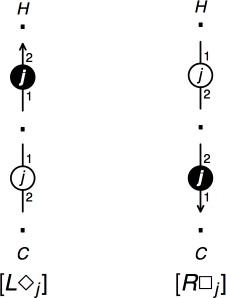![Lexical lookup for [Alice sleeps]](alice_sleeps.jpg)
![Lexical lookup for [Alice sleeps]](alice_sleeps2.jpg)
![Lexical lookup for [Alice sleeps]](alice_sleeps3.jpg)
np to both
nominative case and accusative case pronouns, we would fail to make
any distinction between "she" and "her" and in that case our grammar
would decide that all the sentences below are grammatical.
np into two distinct atomic categories
np_n and np_a, but when we do this we would
have to assign each name, like "Alice" and "Tweedledum" both
of these categories. We'd like to keep the simple np
category for names, yet distinguish between nominative and accusative
case. The unary modes and the contractions for them provide a solution.
engproncase1.pl, developed by Richard T. Oehrle and part of the grammars which
can be downloaded together with Grail, illustrates a simple use of the
unary branches. Load the grammar engproncase1.pl and parse
the first example phrase "Alice sleeps". Grail will display the graph
shown below on the left.
![Lexical lookup for [Alice sleeps]](alice_sleeps.jpg)
![Lexical lookup for [Alice sleeps]](alice_sleeps2.jpg)
![Lexical lookup for [Alice sleeps]](alice_sleeps3.jpg)
The only difference with a normal intransitive verb is the pair of
unary branches connecting the np labeled 5 to the
verb. It is a combination of a main with an auxiliary
constructor.

Figure 3. A graphical representation of the unary contractions with modes
As shown in Figure 3 above, contractions for the unary modes are instances of the same pattern as the contractions for the binary modes: a main and an auxiliary constructor are connected at all points which do not have the arrow pointing towards them in the auxiliary constructor with all other paths leading to the same nodes with the same label. In the figure, it is path 1 to node 3 which has the arrow, so only path 2 from both constructors has to reach the same node, which is four in the current case. In addition, we verify that both constructors have the same mode, n in the current case, like we do with modes in general. In other words, the lexical graph for "sleeps" can immediately be contracted by identifying node 3 and 5 and erasing the pair of unary connections as well as the internal node 4. This means that when we want to, we can use the graph for sleeps as a "normal" intransitive verb.
For the example "Alice sleeps" it is exactly the normal intransitive verb we need. As shown above, we connect the two noun phrases 1 and 5 and the two sentences 6 and 7 to obtain the figure in shown above the in the middle. Then, since we are in a position permitting a contraction (path 2 from both unary links arrives at node 4 and both links have mode n as discussed before) we can remove both unary links and obtain the tree for "Alice sleeps" shown on the right.
![Lexical lookup for [Alice sleeps]](she_sleeps.jpg)
![Lexical lookup for [Alice sleeps]](she_sleeps2.jpg)
![Lexical lookup for [Alice sleeps]](she_sleeps3.jpg)
The intuition is that this lexical graph delivers a noun phrase, but with the special restriction that it can only occur in a nominative context. The intransitive verb sleeps provides such a context. Performing the substitutions as before will give us the graph shown in the middle as a result. This time, there are two active auxiliary constructors (shown in blue) attached to a single main constructor. In addition, both auxiliary constructors can be contracted.
![Lexical lookup for [Alice sleeps]](her_sleeps.jpg)
![Lexical lookup for [Alice sleeps]](her_sleeps2.jpg)
![Lexical lookup for [Alice sleeps]](her_sleeps3.jpg)
The figure above in the middle shows the resulting graph after all substitutions have been performed. In this case, unlike in the case for "She sleeps above", there is only a single contraction possible. Though the top auxiliary connection it connected to a main connection by its single path (path 1) which does not have the arrow, this time the two modes, a for the auxiliary constructor and n for the main constructor, do not correspond. We can only perform contraction [5], which produces the figure shown on the right.
In that figure, the unary auxiliary constructor is connected by means of node 5 to a binary main constructor and no contraction is possible. Therefore, as desired, this sentence is underivable.
When you've derived all sentences in this example grammar, you can see
an implementation English case using only a single mode in the example
grammar engproncase2.pl. Try the examples in this grammar
and see how this is done. The words in the lexicon are slightly
bigger, so this is a good test to see if you've understood the unary
contractions.
Finally, you can see the unary connectives together with structural rules in the next section. If you haven't seen structural rules yet, they are explained in more detail in their own section.